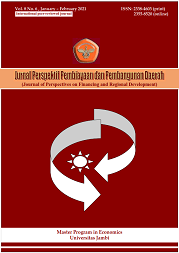Farmers’ technology adoption decision and use intensity in the agricultural sector: Case of Masha Woreda (Double Hurdle Model)
DOI:
https://doi.org/10.22437/ppd.v9i1.10542Keywords:
Agricultural, Double-Hurdle, Masha woreda, Technology adoptionAbstract
This research aimed to critically analyze the determinants of technology adoption and the use intensity by small farm households in the study area (Masha District). Six kebeles were randomly selected from the district, and 251 sample households were proportionally and randomly identified from the selected kebeles. The data collected from the sample households have been analyzed using both descriptive as well as inferential analysis. For inferential analysis, the Double Hurdle Model was adopted to estimate the technology adoption decision as well as use intensity of small farm households in the study area. The findings show that technology adoption decisions were associated with household-specific characteristics such as sex, education, extension, and family size, increasing the likelihood of technology adoption. In contrast, the age of the household head has a negative contribution to it. On the other hand, institutional factors such as access to extension service and access to credit facilities have a significant impact where the latter has contributed negatively to the farmers’ decision regarding technology adoption.
Downloads
References
Ahmed, S. (2004). Factors and Constraints for Adopting New Agricultural Technology in Assam With Special Reference to Nalbari District.: An Empirical Study. Journal of Contemporary Indian Policy, 11, 359-376
Brink. A. B. & Eva, H.D. (2009), "Monitoring 25 years of land cover change dynamics in Africa: A sample based remote sensing approach. Applied Geography, 29(4), 501-512.
Cragg, J. G. (1971). Some Statistical Models for Limited Dependent Variables with Application to the Demand for Durable Goods. Econometrics, 39(5), 829-844.
Gabre-Madhin, Z. & Haggblade, S. (2001). Success in African Agriculture: Results of an Expert Survey. International Food Policy Research Institute. Washington DC. June 2001.
Genius, M., Koundouri, M., Nauges, C & Tzouvelekas, V. (2010). Information Transmission in Irrigation Technology Adoption and Diffusion: Social Learning, Extension Services and Spatial Effects. American Journal of Agricultural Economics, 96(1), 328-344
Jayne, T.S. & D.L. Tschirley (2009). Food price spikes and strategic interactions between the public and private sectors: Market failures or governance failures. Food Security Collaborative Working Papers 97142, Michigan State University, Department of Agricultural, Food, and Resource Economics.
Kasenge, V. (1998). Socioeconomic factors influencing the level of Soil Management Practices on Fragile Land. In Proceedings of the 16th Conference of Soil Science Society of East Africa, 13th-19th, December 1998, Tanga, Tanzania
Lavison, R. (2013). Factors Influencing the Adoption of Organic Fertilizers in Vegetable Production in Accra, [Msc Thesis], Accra Ghana.
Mwangi, M. & Kariuki, S. (2015) Factors Determining Adoption of New Agricultural Technology by Smallholder Farmers in Developing Countries Journal of Economics and Sustainable Development, 6(5), 208-216
New Partnership for Africa’s Development. (2014), Agriculture in Africa: Transformation and Outlook. South Africa: AUDA-NEPAD
OECD/FAO (2016). “Agriculture in Sub-Saharan Africa: Prospects and challenges for the next decadeâ€, in OECD-FAO Agricultural Outlook 2016-2025, Paris: OECD Publishing.
Stoorvogel, J.J., & E. Smaling (1990), Assessment of Soil Nutrient Depletion in Sub-Saharan Africa: 1983-2000. Nutrient Balances per Crop and per Land Use System, Report No. 28, Vol. 2,Winand Staring Center,Wageningen.
Tittonell, P., & K. Giller (2012). When Yield Gaps Are Poverty Traps: The Paradigm of Ecological Intensification in African Smallholder Agriculture. Field Crops Research, 143(1), 76-90.
Uaiene, R., Arndt, C., & Masters, W. (2009). Determinants of Agricultural Technology Adoption in Mozambique. Discussion papers No. 67E
Downloads
Published
How to Cite
Issue
Section
License
Copyright (c) 2021 Amsalu Dachito, Alebachew Angelo

This work is licensed under a Creative Commons Attribution 4.0 International License.

















